Impact of Cloud Microphysics Initialization Using Satellite and Radar Data on CMA-MESO Forecasts
Abstract
1. Introduction
2. Materials and Methods
2.1. CMA-MESO 3 km Numerical Weather Prediction System
2.2. Initial Analysis and Assimilation of Cloud Microphysical Variables
2.2.1. Background Field Cloud Fraction Scheme
- is assigned as 0.95 at altitudes below 600 m; 0.9 between 600 and 1500 m; 0.85 between 1500 and 2500 m; and 0.8 above 2500 m.
- Parameter b is set to 2.
2.2.2. Satellite Data and Cloud Microphysical Variable Initialization Analysis
- For Tbo < −20 °C: Match satellite brightness temperature to grid temperature profile.
- For Tbo ≥ −20 °C: Use MacPherson’s moist adiabatic ascent method [30].
2.2.3. Radar Data and Cloud Microphysical Variable Initialization Analysis
2.2.4. False Cloud Elimination
2.3. Cloud Microphysics Initialization Scheme
2.4. Numerical Experiment Design
3. Analysis of Case Experiment Results
3.1. Analysis of Cloud Microphysical Initialization Fields
3.2. Effects of Cloud Microphysics Initial Conditions on Forecasting
- Impact Analysis of Rainwater Mixing Ratio Forecast
- Impact Analysis of Cloud Forecast
- Impact Analysis of Precipitable Water Vapor (PWV) Forecast
- Impact Analysis of Precipitation Forecast
- Thermodynamic Response Analysis
4. Analysis of Continuous Experiment Results
4.1. Influence on Precipitation
4.2. Analysis of the Influence on 2 m Temperature Forecasts
4.3. Impacts on Geopotential Height Forecasts
4.4. Impacts on 10 m Wind Forecasts
5. Discussion
6. Conclusions
- The effective analysis and assimilation of cloud microphysical initial values significantly reduced the model spin-up time, accelerating rainwater prediction. The 1 h forecast successfully captured heavy precipitation cloud clusters with a spatial pattern consistent with those of observations, accompanied by a notable improvement in precipitation scores. These results demonstrate a substantial enhancement in the nowcasting capability for heavy precipitation events.
- The 0–12 h precipitation forecast accuracy was comprehensively enhanced, with the improvements persisting throughout the entire 72 h forecast window. Following the application of initial cloud microphysical-related variable values, the 1 h precipitation ETS demonstrated substantial improvements: from 0.083 to 0.41 (+396%) for light rain, 0.043 to 0.36 (+736%) for moderate rain, and 0.007 to 0.217 (+2971%) for heavy rain. Within the 2–6 h forecast range, the hourly ETSs for light to heavy precipitation exhibited mean enhancements of 21–71%. The ETSs for light, moderate, and heavy rain increased by 7.5%, 9.8%, and 24.9% at 7–12 h, with limited improvement beyond 12 h.
- The forecast accuracies for temperature, geopotential height, and wind fields simultaneously improved. Following the application of initial cloud microphysical-related variable values, the RMSE of the 2 m temperature forecasts decreased throughout the 1–72 h range, with an average reduction of 4.2% during 1–9 h. For geopotential height fields, the RMSE decreased by 5.8%, 3.3%, and 2.0% with 24 h, 48 h, and 72 h lead times, respectively. Improvements were also observed in the 10 m wind field forecasts. These results demonstrate that cloud microphysical initial values can systematically enhance model prediction through radiation–thermodynamic feedback mechanisms.
Author Contributions
Funding
Data Availability Statement
Acknowledgments
Conflicts of Interest
References
- Hong, S.-Y.; Sunny Lim, K.-S.; Kim, J.-H.; Jade Lim, J.-O.; Dudhia, J. Sensitivity Study of Cloud-Resolving Convective Simulations with WRF Using Two Bulk Microphysical Parameterizations: Ice-Phase Microphysics versus Sedimentation Effects. J. Appl. Meteorol. Climatol. 2009, 48, 61–76. [Google Scholar] [CrossRef]
- Kalnay, E. Atmospheric Modeling, Data Assimilation and Predictability; Cambridge University Press: Cambridge, UK, 2002. [Google Scholar] [CrossRef]
- Stensrud, D.J. Parameterization Schemes Keys to Understanding Numerical Weather Prediction Models; Cambridge University Press: Cambridge, UK, 2009. [Google Scholar]
- Sun, J.Z.; Trier, S.B.; Xiao, Q.N.; Weisman, M.L.; Wang, H.L.; Ying, Z.M.; Xu, M.; Zhang, Y. Sensitivity of 0-12-h warm-season precipitation forecasts over the central United States to model initialization. Weather Forecast. 2012, 27, 832–855. [Google Scholar] [CrossRef]
- Shen, F.; Xu, D.; Min, J. Effect of momentum control variables on assimilating radar observations for the analysis and forecast for Typhoon Chanthu (2010). Atmos. Res. 2019, 230, 104622. [Google Scholar] [CrossRef]
- Song, L.; Shen, F.; Shao, C.; Shu, A.; Zhu, L. Impacts of 3DEnVar-Based FY-3D MWHS-2 Radiance Assimilation on Numerical Simulations of Landfalling Typhoon Ampil (2018). Remote Sens. 2022, 14, 6037. [Google Scholar] [CrossRef]
- Xu, D.; Liu, Z.; Fan, S.; Chen, M.; Shen, F. Assimilating All-sky Infrared Radiances from Himawari-8 Using the 3DVar Method for the Prediction of a Severe Storm over North China. Adv. Atmos. Sci. 2021, 38, 661–676. [Google Scholar] [CrossRef]
- Chen, W.M. Satellite Meteorology; China Meteorlgical Press: Beijing, China, 2017. (In Chinese) [Google Scholar]
- Doviak, R.J.; Zrnić, D.S. Doppler Radar and Weather Observations; Academic Press: Cambridge, MA, USA, 1993. [Google Scholar] [CrossRef]
- Bieringer, P.; Ray, P.S. A Comparison of Tornado Warning Lead Times with and without NEXRAD Doppler Radar. Weather Forecast. 1996, 11, 47–52. [Google Scholar] [CrossRef]
- Polger, P.D.; Goldsmith, B.S.; Przywarty, R.C.; Bocchieri, J.R. National Weather Service Warning Performance Based on the WSR-88D. Bull. Am. Meteorol. Soc. 1994, 75, 203–214. [Google Scholar] [CrossRef]
- Huuskonen, A.; Saltikoff, E.; Holleman, I. The Operational Weather Radar Network in Europe. Bull. Am. Meteorol. Soc. 2014, 95, 897–907. [Google Scholar] [CrossRef]
- Min, C.; Chen, S.; Gourley, J.J.; Chen, H.; Zhang, A.; Huang, Y.; Huang, C. Coverage of China New Generation Weather Radar Network. Adv. Meteorol. 2019, 2019, 5789358. [Google Scholar] [CrossRef]
- De Haan, S.; van der Veen, S.H. Cloud Initialization in the Rapid Update Cycle of HIRLAM. Weather Forecast. 2014, 29, 1120–1133. [Google Scholar] [CrossRef]
- Benjamin, S.G.; James, E.P.; Hu, M.; Alexander, C.R.; Ladwig, T.T.; Brown, J.M.; Weygandt, S.S.; Turner, D.D.; Minnis, P.; Smith, W.L.; et al. Stratiform Cloud-Hydrometeor Assimilation for HRRR and RAP Model Short-Range Weather Prediction. Mon. Weather Rev. 2021, 149, 2673–2694. [Google Scholar] [CrossRef]
- Renshaw, R.; Francis, P.N. Variational assimilation of cloud fraction in the operationalMet Office Unified Model. Q. J. R. Meteorol. Soc. 2011, 137, 1963–1974. [Google Scholar] [CrossRef]
- Albers, S.C.; McGinley, J.A.; Birkenheuer, D.L.; Smart, J.R. The Local Analysis and Prediction System (LAPS): Analyses of Clouds, Precipitation, and Temperature. Weather Forecast. 1996, 11, 273–287. [Google Scholar] [CrossRef]
- Zhang, J. Moisture and Diabatic Initialization Based on Radar and Satellite Observations. Ph.D. Thesis, University of Oklahoma, Norman, OK, USA, 1999. [Google Scholar]
- Xue, M.; Wang, D.; Gao, J.; Brewster, K.; Droegemeier, K. The Advanced Regional Prediction System (ARPS), storm-scale numerical weather prediction and data assimilation. Meteorol. Atmos. Phys. 2003, 82, 139–170. [Google Scholar] [CrossRef]
- Hu, M.; Xue, M.; Brewster, K. 3DVAR and Cloud Analysis with WSR-88D Level-II Data for the Prediction of the Fort Worth, Texas, Tornadic Thunderstorms. Part I: Cloud Analysis and Its Impact. Mon. Weather Rev. 2006, 134, 675–698. [Google Scholar] [CrossRef]
- Chen, D.; Xue, J.; Yang, X.; Zhang, H.; Shen, X.; Hu, J.; Wang, Y.; Ji, L.; Chen, J. New generation of multi-scale NWP system (GRAPES): General scientific design. Chin. Sci. Bull. 2008, 53, 3433–3445. [Google Scholar] [CrossRef]
- Mlawer, E.J.; Taubman, S.J.; Brown, P.D.; Iacono, M.J.; Clough, S.A. Radiative transfer for inhomogeneous atmospheres: RRTM, a validated correlated-k model for the longwave. J. Geophys. Res. Atmos. 1997, 102, 16663–16682. [Google Scholar] [CrossRef]
- Dudhia, J. A nonhydrostatic version of the Penn State-NCAR mesoscale model: Validation tests and simulation of an Atlantic cyclone and cold front. Mon. Weather Rev. 1993, 121, 1493–1513. [Google Scholar] [CrossRef]
- Chen, F.; Dudhia, J. Coupling an advanced land surface–hydrology model with the penn state–NCAR MM5 modeling system. Part I: Model implementation and sensitivity. Mon. Weather Rev. 2001, 129, 569–585. [Google Scholar] [CrossRef]
- Hong, S.-Y.; Pan, H.-L. Nonlocal Boundary Layer Vertical Diffusion in a Medium-Range Forecast Model. Mon. Weather Rev. 1996, 124, 2322–2339. [Google Scholar] [CrossRef]
- Hong, S.-Y.; Dudhia, J.; Chen, S.-H. A revised approach to ice Microphysical Processes for the Bulk Parameterization of Clouds and Precipitation. Mon. Weather Rev. 2004, 132, 103–120. [Google Scholar] [CrossRef]
- Koch, S.E.; Aksakal, A.; McQueen, J.T. The Influence of Mesoscale Humidity and Evapotranspiration Fields on a Model Forecast of a Cold-Frontal Squall Line. Mon. Weather Rev. 1997, 125, 384–409. [Google Scholar] [CrossRef]
- Weygandt, S.S.; Benjamin, S.G.; Hu, M.; Alexander, C.R.; Smirnova, T.G.; James, E.P. Radar Reflectivity–Based Model Initialization Using Specified Latent Heating (Radar-LHI) within a Diabatic Digital Filter or Pre-Forecast Integration. Weather Forecast. 2022, 37, 1419–1434. [Google Scholar] [CrossRef]
- Xu, J.; Zhang, W.J.; Yang, J.; Cheng, Z.L. Fengyun-2 Satellite Operational Products and Data Format Practical Handbook; China Meteorological Press: Beijing, China, 2008. (In Chinese) [Google Scholar]
- Macpherson, B.; Wright, B.J.; Hand, W.H.; Maycock, A.J. The Impact of MOPS Moisture Data in the U.K. Meteorological Office Mesoscale Data Assimilation Scheme. Mon. Weather Rev. 1996, 124, 1746–1766. [Google Scholar] [CrossRef][Green Version]
- Hu, M. 3DVAR and Cloud Analysis with WSR-88D Level-II Data for the Prediction of Tornadic Thunderstorms. Ph.D. Thesis, University of Oklahoma, Norman, OK, USA, 2005. [Google Scholar]
- Smith, P.L.; Myers, C.G.; Orville, H.D. Radar Reflectivity Factor Calculations in Numerical Cloud Models Using Bulk Parameterization of Precipitation. J. Appl. Meteorol. Climatol. 1975, 14, 1156–1165. [Google Scholar] [CrossRef]
- Tong, M.; Xue, M. Ensemble Kalman Filter Assimilation of Doppler Radar Data with a Compressible Nonhydrostatic Model: OSS Experiments. Mon. Weather Rev. 2005, 133, 1789–1807. [Google Scholar] [CrossRef]
- Bloom, S.C.; Takacs, L.L.; da Silva, A.M.; Ledvina, D. Data Assimilation Using Incremental Analysis Updates. Mon. Weather Rev. 1996, 124, 1256–1271. [Google Scholar] [CrossRef]
- Lee, M.-S.; Kuo, Y.-H.; Barker, D.M.; Lim, E. Incremental Analysis Updates Initialization Technique Applied to 10-km MM5 and MM5 3DVAR. Mon. Weather Rev. 2006, 134, 1389–1404. [Google Scholar] [CrossRef]
- Takacs, L.L.; Suárez, M.J.; Todling, R. The Stability of Incremental Analysis Update. Mon. Weather Rev. 2018, 146, 3259–3275. [Google Scholar] [CrossRef] [PubMed]
- Lingkun, R.; Shuwen, L.; Yushu, Z.; Shuai, Y.; Shuping, M.; Kuo, Z.; Dongdong, S.; Baofeng, J.; Na, L. Observational Analysis of the Dynamic, Thermal, and Water Vapor Characteristics of the “7.20” Extreme Rainstorm Event in Henan Province. Chin. J. Atmos. Sci. 2021, 45, 1366–1383. [Google Scholar] [CrossRef]
- Chen, G.; Sha, W.; Iwasaki, T. Diurnal variation of precipitation over southeastern China: Spatial distribution and its seasonality. J. Geophys. Res. 2009, 114, D13103. [Google Scholar] [CrossRef]
- Tang, J.; Chen, S.; Li, Z.; Gao, L. Mapping the Distribution of Summer Precipitation Types over China Based on Radar Observations. Remote Sens. 2022, 14, 3437. [Google Scholar] [CrossRef]
- Zhao, Y.-C.; Wang, Y.-H. A Review of Studies on Torrential Rain During Pre-Summer Flood Season in South China Since the 1980’s. Torrential Rain Disasters 2009, 28, 194–228. [Google Scholar]
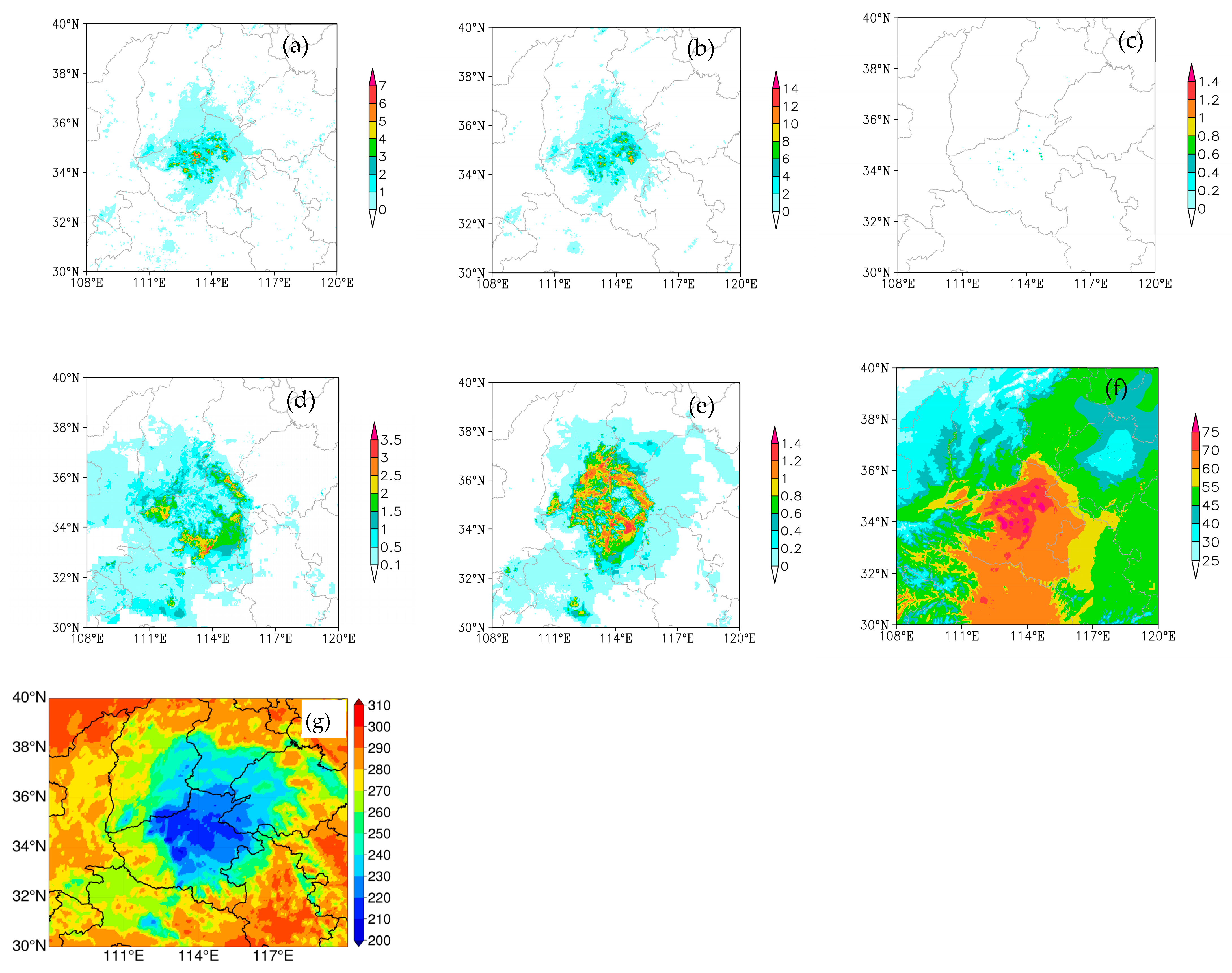

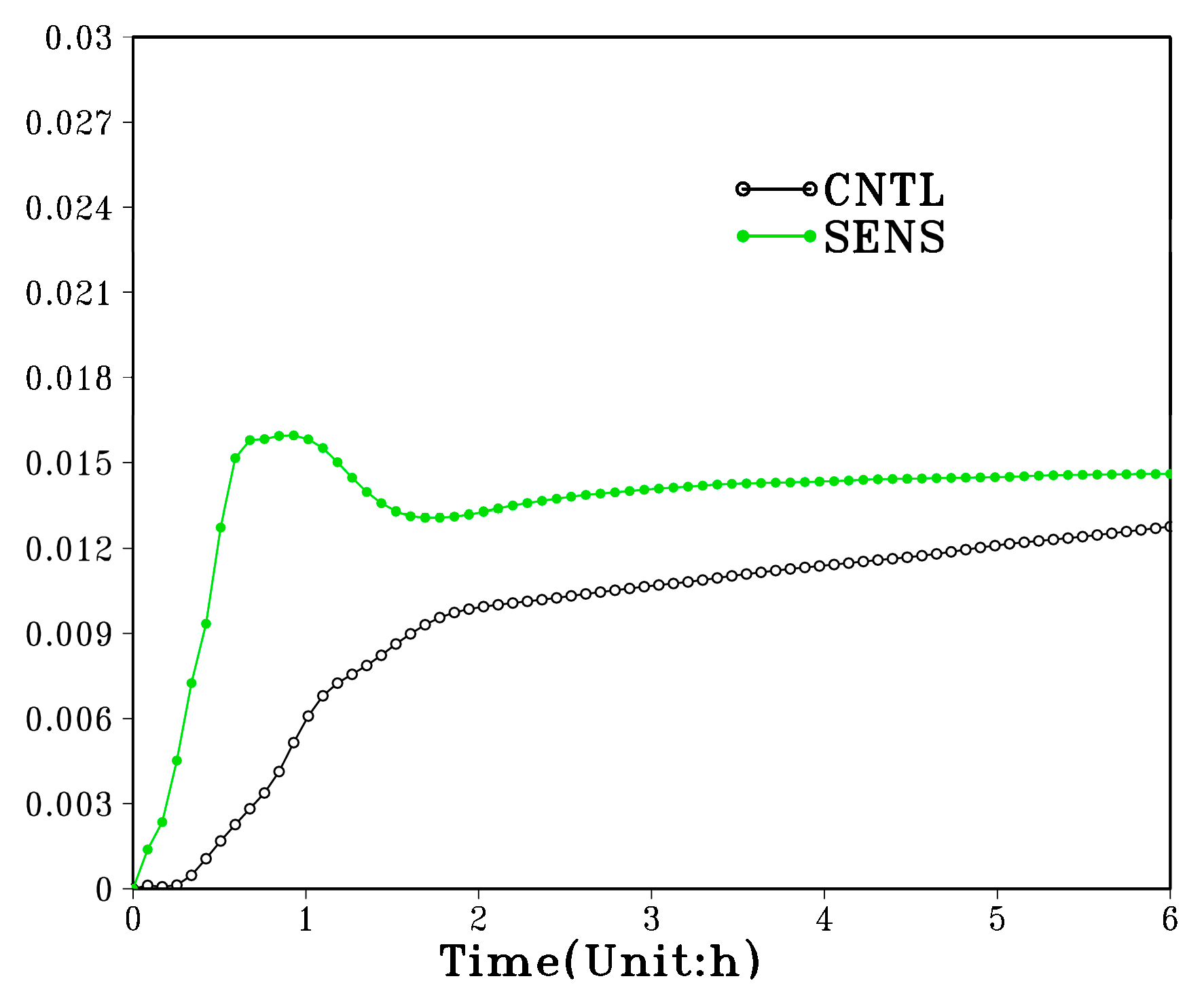



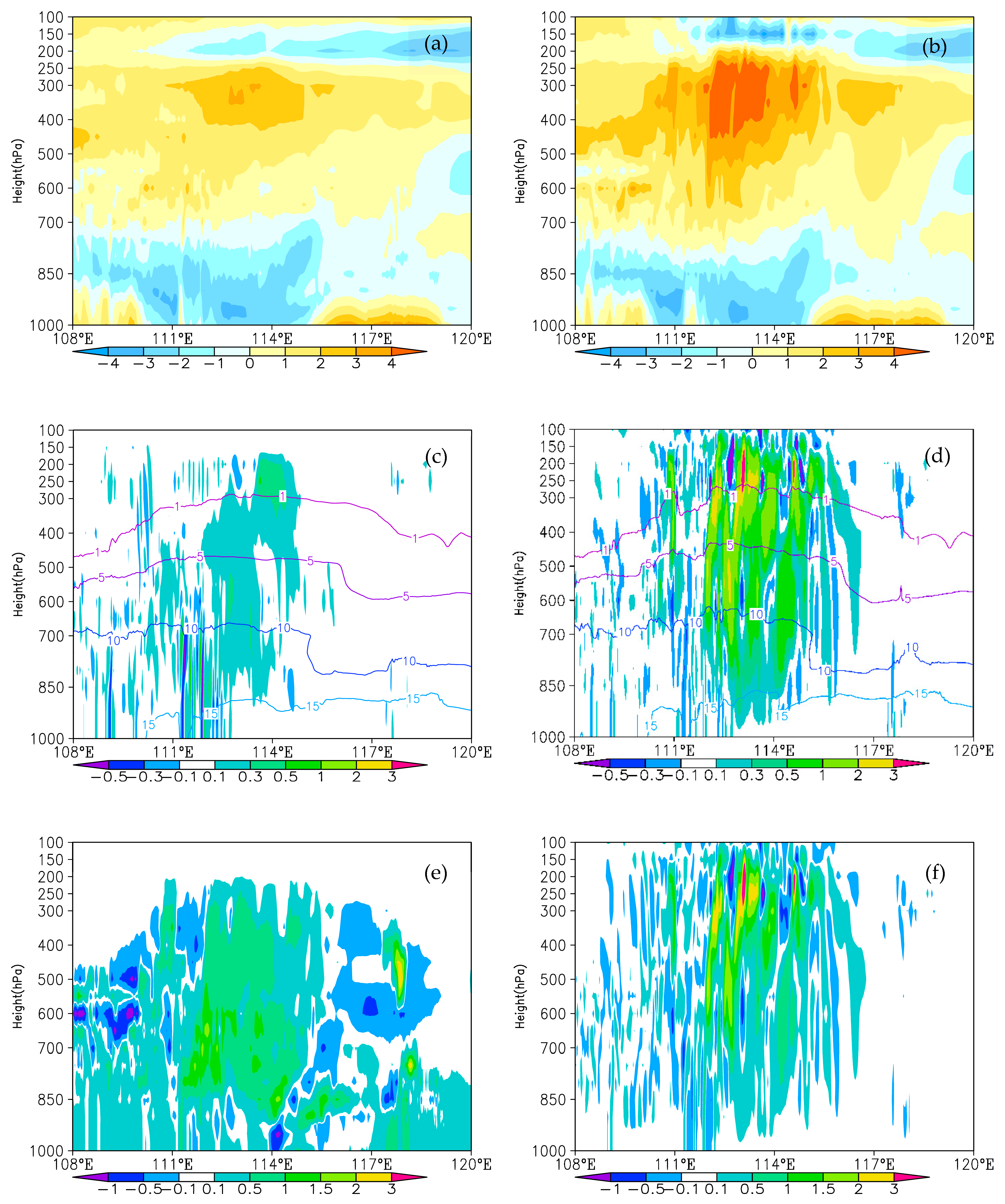
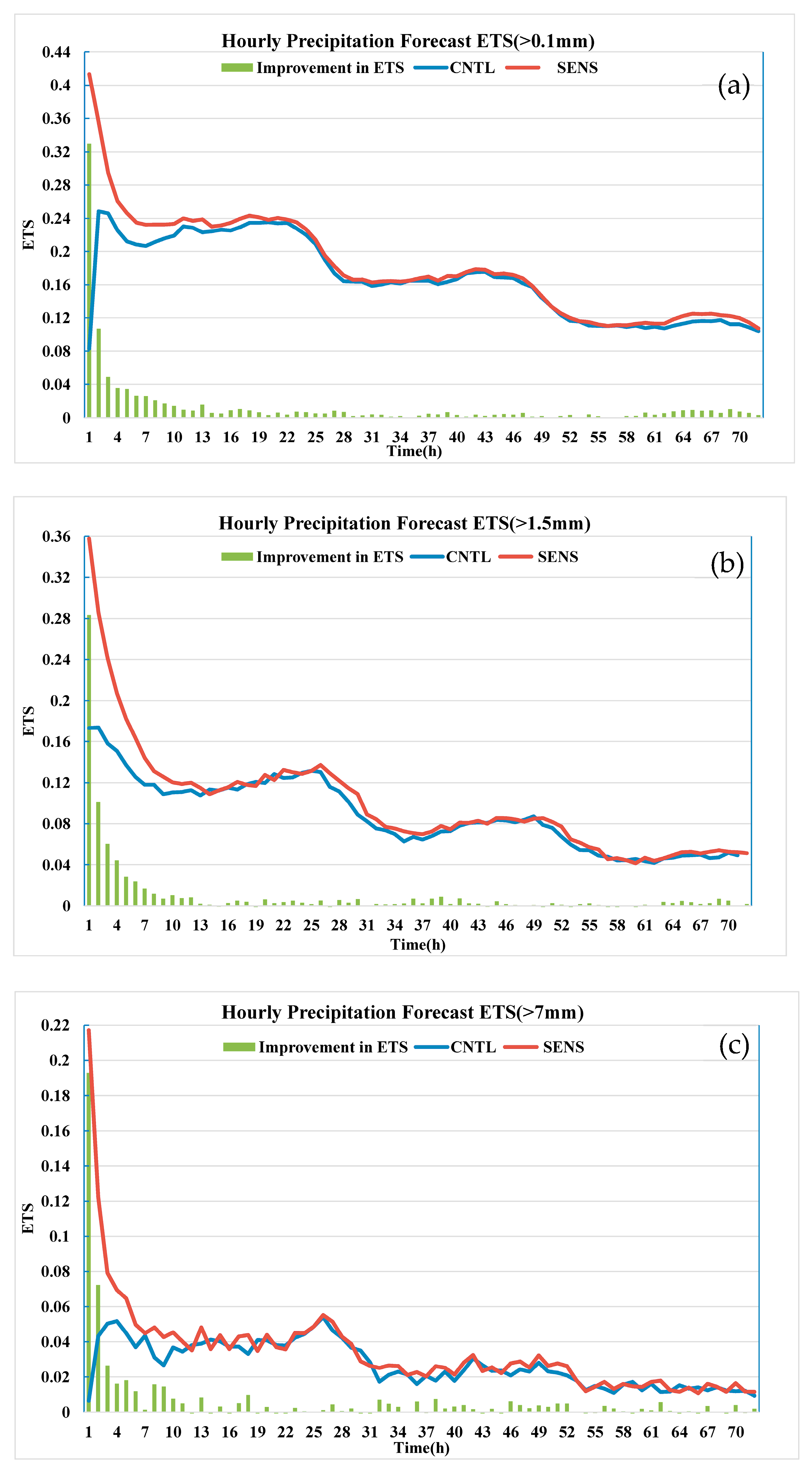
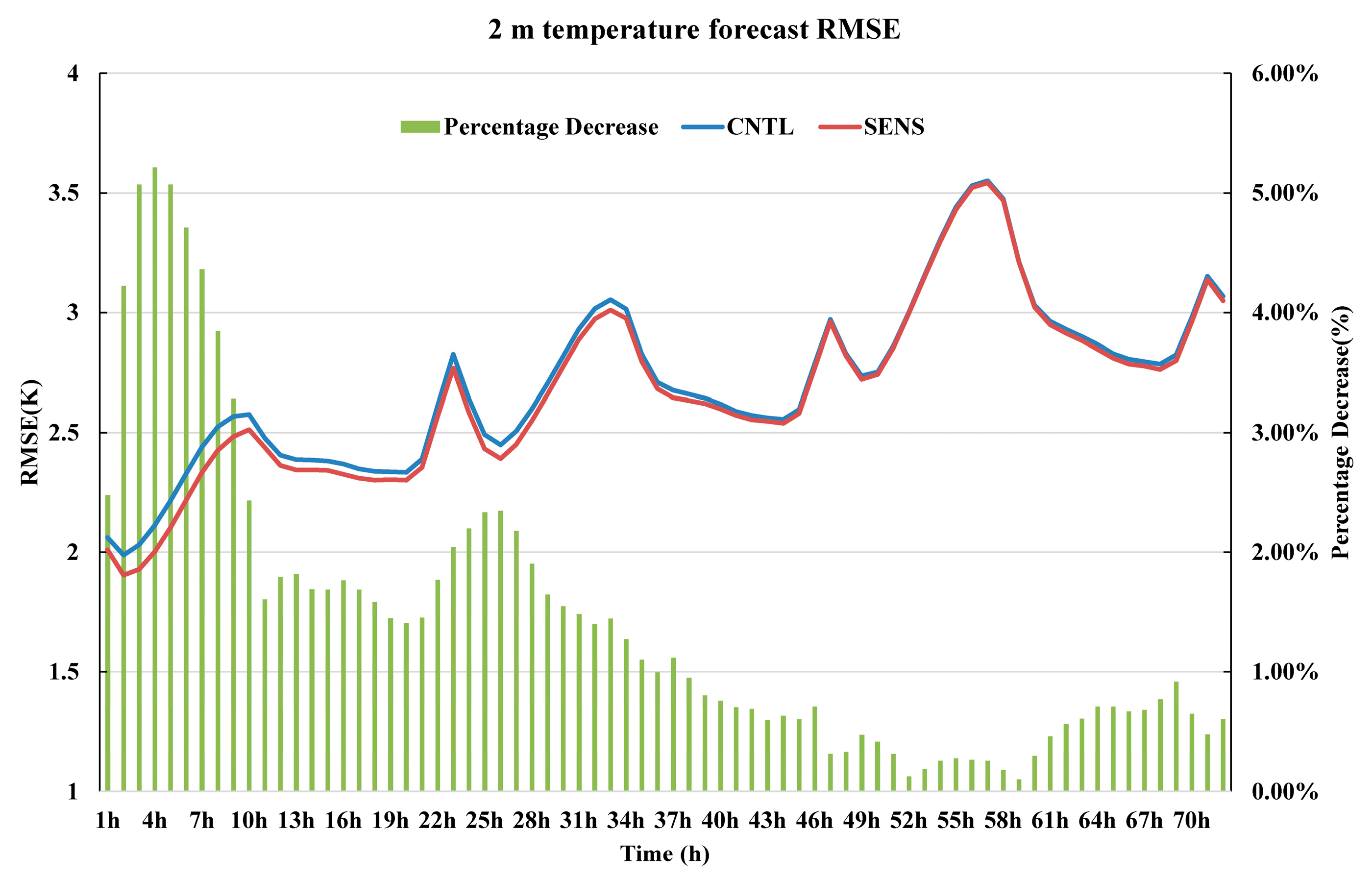

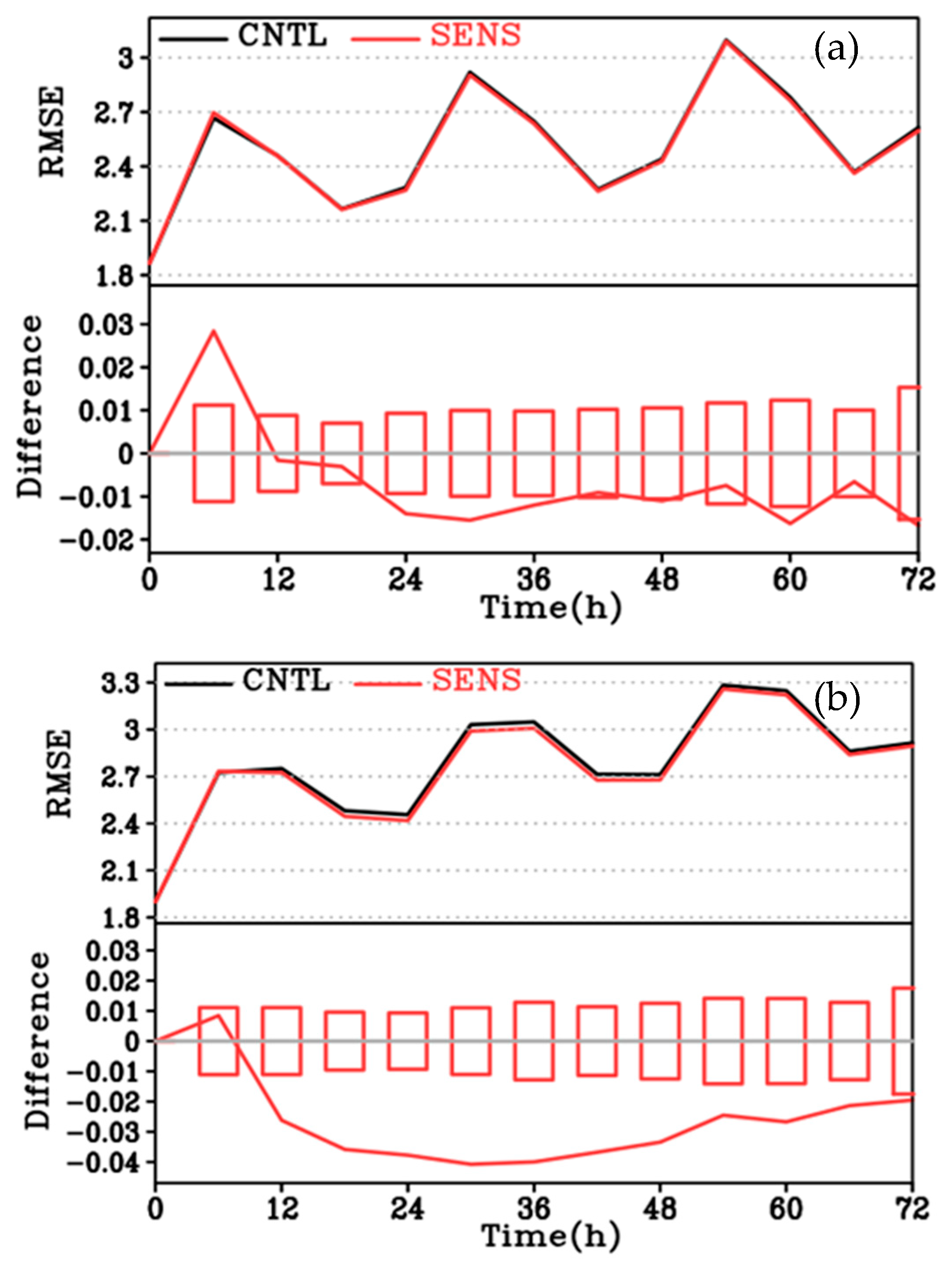
| Model Setup Type | Detailed Settings |
|---|---|
| Model version | CMA-MESO5.1 |
| Resolution | Horizontal grid spacing of 0.03° and 50 sigma vertical levels |
| Grid points and model domain | 2501 × 1671(70°E~145°E,10°N~60.1°N) |
| Radiation scheme | RRTM long-wave radiation scheme [22] Dudhia short-wave radiation scheme [23] |
| Land surface scheme | Noah land surface scheme [24] |
| Boundary layer scheme | MRF planetary boundary layer scheme [25] |
| Cloud microphysics scheme | WSM6 cloud microphysics scheme [26] |
| Assimilation scheme | 3DVAR and cloud analysis |
| Assimilation data | Radiosonde, Airep, Synop, ships and buoys, atmospheric motion vectors (AMVs), radar VAD (velocity azimuth display), wind profiles, and GPS/PW and surface observations. |
Disclaimer/Publisher’s Note: The statements, opinions and data contained in all publications are solely those of the individual author(s) and contributor(s) and not of MDPI and/or the editor(s). MDPI and/or the editor(s) disclaim responsibility for any injury to people or property resulting from any ideas, methods, instructions or products referred to in the content. |
© 2025 by the authors. Licensee MDPI, Basel, Switzerland. This article is an open access article distributed under the terms and conditions of the Creative Commons Attribution (CC BY) license (https://creativecommons.org/licenses/by/4.0/).
Share and Cite
Zhu, L.; Jiang, Y.; Gong, J.; Wang, D. Impact of Cloud Microphysics Initialization Using Satellite and Radar Data on CMA-MESO Forecasts. Remote Sens. 2025, 17, 2507. https://doi.org/10.3390/rs17142507
Zhu L, Jiang Y, Gong J, Wang D. Impact of Cloud Microphysics Initialization Using Satellite and Radar Data on CMA-MESO Forecasts. Remote Sensing. 2025; 17(14):2507. https://doi.org/10.3390/rs17142507
Chicago/Turabian StyleZhu, Lijuan, Yuan Jiang, Jiandong Gong, and Dan Wang. 2025. "Impact of Cloud Microphysics Initialization Using Satellite and Radar Data on CMA-MESO Forecasts" Remote Sensing 17, no. 14: 2507. https://doi.org/10.3390/rs17142507
APA StyleZhu, L., Jiang, Y., Gong, J., & Wang, D. (2025). Impact of Cloud Microphysics Initialization Using Satellite and Radar Data on CMA-MESO Forecasts. Remote Sensing, 17(14), 2507. https://doi.org/10.3390/rs17142507





